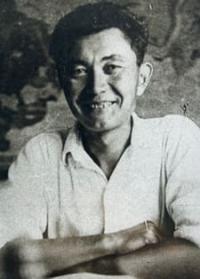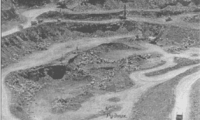You are here
Manganese mine in Zhezdy.


Photos of Ulytau.
“We are obliged not only to develop our deposits of underground minerals, but also to protect them!”
Kanysh Satpayev.
Walk and visit to Zhezda.
The Zhezdy manganese mine was opened in 1942 on the personal initiative of K. Satpayev. A large deposit of manganese in the USSR, the Nikopol basin, was occupied by the Germans, and difficulties arose in transporting Chiatura ores.
It was necessary to establish the production of valuable strategic raw materials in close proximity to metallurgical plants in the Urals and Siberia. The Central Committee of the CPSU and the Soviet government will instruct scientists, as soon as possible, to find a deposit where the industrial development of manganese ore could begin.
And in the summer of 1941, at the beginning of the war. K. Satpayev and geologists of Dzhezkazgan submitted to government bodies a proposal for the development of the Zhezdy manganese ore deposit.
In the fall of 1941, K. Satpayev and S. Seifullin made the first calculation of the manganese ore reserves of this deposit, which was approved by the State Reserves Committee at the beginning of 1942.
However, some experts at that time doubted whether the Zhezdinskoye deposit would be able to satisfy the demands of metallurgical plants in the eastern regions of the country, and proposed postponing development until the completion of geological exploration work.
K. Satpayev did not agree with this opinion. He was so confident in the prospects of the deposit that he took full responsibility upon himself and guaranteed ore reserves for many years. The authority of the recognized Kazakh geologist carried weight, and the government accepted his proposal.
The Zhezdinskoye deposit was identified as the most profitable for development, and on April 25, 1942, an order was issued by the People's Commissar of Ferrous Metallurgy of the USSR - “On the organization of mining of manganese ore from the Zhezdy deposit of the Kazakh SSR.”
In April 1942, construction began on an important facility - the Zhezdy manganese mine. In parallel with this, work on the exploitation of the field begins. One of the factors that ensured the rapid development of the deposit was the location of the ore layers close to the surface, which made it possible to immediately begin mining operations without special costs.
Therefore, the designers divided the operation of the field into two stages. At the first, it was decided to develop ore deposits in an open way, and at the second, to develop ores located in the depths of the subsoil using an underground method.
In total, 17 ore deposits were recorded at the deposit. Despite the difficult conditions, the team worked selflessly, day and night, with high labor productivity. As a result, on June 12, 1942, the first batch of manganese ore was shipped.
This happened in 38 days, and the date June 12, 1942 became the birthday of the Zhezdy manganese mine. From that moment on, the mine began to operate according to the state plan. Subsequently, it increased its capacity, and the Ural metallurgical plants began to be uninterruptedly supplied with manganese.
During the war years, hundreds of workers and engineers worked selflessly at the mine, fulfilling the urgent task of the government to provide metallurgical plants in the eastern part of the country with strategic raw materials.
The mine operated at the same pace in the post-war years. The mined ore satisfied the needs of the Magnitogorsk Metallurgical Plant until 1955. However, due to changes that occurred in the technology of the plant, in May an order was issued by the Minister of Ferrous Metallurgy of the USSR on the extraction of only 10,000 tons of manganese ore at the Zhezdy mine, and from August 1, 1955 on the transfer of the mine to wet conservation and the dismantling of equipment.
This was a big blow for the team of a stably operating enterprise, which produced up to 200 - 210,000 tons of ore per year. Taking into account the promising capabilities of the mine, the management of the mine management appeals to the USSR MFM with a proposal to preserve it, bring the production plan to 190,000 tons with the storage of ore in the State Reserve, accelerate the construction of the processing plant and its commissioning.
As a result of numerous correspondence and negotiations, in May 1955, a special decision was made by the USSR Council of Ministers on preserving the Zhezdy mine and establishing a minimum plan for ore production with storage on site and transfer to the State Reserve.
But already in 1965, with the launch of an enrichment plant, the production of manganese ores was increased. Manganese concentrate was supplied to the West Siberian Metallurgical Plant, and later to other plants in the Urals - NTMK, Serovsky KZRGO, Alapaevsky, as well as Karmetkobinat. Thus, from 1942 to 1995, the Zhezdy mine administration produced and enriched manganese ores. During the development of the mine, a strong, close-knit team of miners, enrichers and builders grew up there.
Many veterans from Zhezda made their contribution to the development of the mine. Unfortunately, many of them have not been with us for a long time, and on this day I would like to remember their names. These are mine drillers - A. Alibaev, Sh. Zhuvanishev, A. Nurekenov, N. Kulikov, 3. Getman, K. Sadvakaosv, U. Bukbaev, A. Nurmagambetov, I. Patogin, S. Absalykov. Sh. Ismagulov. explosives - K. Dosetov. B, Seilov, K. Akishev, electrical mechanics - V. Kabeev, T. Aimagambetov, E. Abzalov, E. Kazban, V. Shcherbatyuk, enrichment workers - T. Nurmagambetov, Zh. Telbaev, R. Zhodtsybaev. builders - K. Konurshinov, A. Abildinov, M. Maslov, V. Fetter. electric welders - N. Mokh, R. Fetter, K. Akylbekov. Sh. Umirbekov and others.
Many of them were awarded the Order of Lenin. Red Banner of Labor and other high government awards. After the collapse of the Union in 1993, the joint-stock company “Kazakhmarganets” was organized on the basis of the Zhezdy RU, which ceased to exist in 1997. Now the mines are in deep conservation.
At the mine at the beneficiation plant there is only a unit for washing ore screenings from the Tur deposit (a workshop of the Aksu Ferroalloy Plant), which employs about 60 - 80 people. The Museum of the History of Mining and Smelting in the village of Zhezdy stores mining equipment that was used during the development of the deposit, there are also stands with portraits of pioneer builders and veterans of production, there are written memoirs of former veterans who arrived from different parts of the country about the builder from the mine.
Every year from the date of formation of the Zhezdy mine administration, which turned 60 years old, is an imperishable line in the history of the mine.
Geographic coordinates of Zhezdy field: N48°02'49.16" E67°04'56.53"
Note:
If you are using geographic coordinates for Google Earth or Google Maps navigation systems, you must remove the last two digits from geographic coordinates and " (hundredths of a second) and enter the result in the input line. Example: N51°44'09.67" E72°39'40.81" = N51°44'09 E72°39'40
Authority and photos by
B. Aimagambetov. Head of the mining sector of the museum of the history of mining and smelting in the village of Zhezdy.







